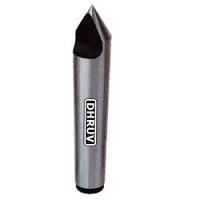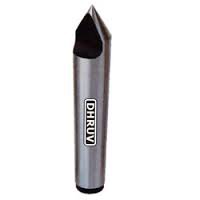-
Welcome back Guest! Did you know you can mentor other members here at H-M? If not, please check out our Relaunch of Hobby Machinist Mentoring Program!
You are using an out of date browser. It may not display this or other websites correctly.
You should upgrade or use an alternative browser.
You should upgrade or use an alternative browser.
Machining between centers
- Thread starter Glmphoto
- Start date
- Joined
- Feb 20, 2014
- Messages
- 20
- Joined
- Apr 23, 2011
- Messages
- 2,476
Geoff,
Half centres are used with the flat orientated vertically and towards the operator. This allows the tool to be run very close to the centre without interfering.
You will note that the bearing section of the half centre is still complete.
Cheers Phil
Half centres are used with the flat orientated vertically and towards the operator. This allows the tool to be run very close to the centre without interfering.
You will note that the bearing section of the half centre is still complete.
Cheers Phil
Re: "half center" option
Thanks for the comment. I have never used one either. I believe a half center is used in the tail stock. It is a dead center and does not drive the work piece. It also does not eliminate the need for a dog on the piece which is the big reason it must be flipped. I understand the half center allows the part to be faced complete. I usually face complete with a full center just bringing the tool into light contact. The dead center is hardened and does not cut. I learned early on to prep the area around my centers drills when drilling them so the need to face down to the center is eliminated all together. Thanks again for the input.
Thanks for the comment. I have never used one either. I believe a half center is used in the tail stock. It is a dead center and does not drive the work piece. It also does not eliminate the need for a dog on the piece which is the big reason it must be flipped. I understand the half center allows the part to be faced complete. I usually face complete with a full center just bringing the tool into light contact. The dead center is hardened and does not cut. I learned early on to prep the area around my centers drills when drilling them so the need to face down to the center is eliminated all together. Thanks again for the input.
- Joined
- Feb 20, 2014
- Messages
- 20
This video concurs with GlmPhoto and 12 bolts: [video=youtube;ijLlTV---as]http://www.youtube.com/watch?v=ijLlTV---as[/video]
This Wikipedia article implicitly concurs and points out the situation in which a half-center is useful: When a steady rest is not available and facing is required on the end of a long shaft. http://en.wikipedia.org/wiki/Lathe
Thanks folks.
This Wikipedia article implicitly concurs and points out the situation in which a half-center is useful: When a steady rest is not available and facing is required on the end of a long shaft. http://en.wikipedia.org/wiki/Lathe
Thanks folks.
- Joined
- Jun 7, 2013
- Messages
- 10,142
What is the reason to be turning between centers with a dog? I just finished the same job an hour or so ago. All I did was chuck it up, face, turn to nominal, single point to my check nut, ran a file over the threads and wire brushed. End for ended it and repeated. Removed from lathe and installed.
What did I do wrong?:thinking:
I just depends how accurate your chuck is; if one wants the shaft to be concentric end for end, the turning between centers is the best way to insure it; for a table saw arbor, accuracy and concentricity are good things, so that one does not cause inacuracy in the turning saw blade; a tiny wobble is not a good thing for fine work.
One drawback in turningbetween centers is that the setup is not as ridgid as chucking, and chatter can be the result.
sometimes it helps to write out a list of operations in the order you intend to perform them.
a lathe dog is clamped onto your work piece at the faceplate.
if you cut threads on one end and then turn it around . . . the lathe dog will now be clamped onto a threaded end. Damaging your newly cut threads.
Question: can the work piece pass through your head stock? If yes than the answer is to finish the shaft using the chuck and not between centers.
so before you start have the following info:
what will the length of the shaft be when finished?
what thread size will you be cutting?
does one end need to have a left hand thread? [very common]
list of operations:
1) pass work piece through head stock leaving 1-2 inches exposed. face off end of shaft, center drill
2)turn work pice around, face to desired length, then center drill.
3) remove chuck install face plate, install work piece between centers.
turning cut cleans up shaft, then cut ends to desired radius and length for threading operations.
4) remove face plate, re-install chuck, pass work piece through head stock, thread cut end of shaft
5)turn shaft around and thread cut other end. [left cut or right as required]
does this sound like what you are tying to do?
see how step 2 says "face to desired length" if you forget to do that . . . you could be a a world of hurt.
can you pass the workpiece through your head stock? if you have a hobby sized lathe you might not be able to do this project. you may be able to use a steady rest. Do you have a steady rest?
If you have to use a steady rest . . . you need a different list of operations.
hope this helps. post some pictures of your project.
-mack318
a lathe dog is clamped onto your work piece at the faceplate.
if you cut threads on one end and then turn it around . . . the lathe dog will now be clamped onto a threaded end. Damaging your newly cut threads.
Question: can the work piece pass through your head stock? If yes than the answer is to finish the shaft using the chuck and not between centers.
so before you start have the following info:
what will the length of the shaft be when finished?
what thread size will you be cutting?
does one end need to have a left hand thread? [very common]
list of operations:
1) pass work piece through head stock leaving 1-2 inches exposed. face off end of shaft, center drill
2)turn work pice around, face to desired length, then center drill.
3) remove chuck install face plate, install work piece between centers.
turning cut cleans up shaft, then cut ends to desired radius and length for threading operations.
4) remove face plate, re-install chuck, pass work piece through head stock, thread cut end of shaft
5)turn shaft around and thread cut other end. [left cut or right as required]
does this sound like what you are tying to do?
see how step 2 says "face to desired length" if you forget to do that . . . you could be a a world of hurt.
can you pass the workpiece through your head stock? if you have a hobby sized lathe you might not be able to do this project. you may be able to use a steady rest. Do you have a steady rest?
If you have to use a steady rest . . . you need a different list of operations.
hope this helps. post some pictures of your project.
-mack318
- Joined
- Dec 31, 2010
- Messages
- 937
There are a lot of good comments here, so I am going to put in my $0.02 worth. In order to get the best fit prior to finishing I leave the work overnight either loose or out of the lathe. I think this helps in 2 ways: 1. stress relieving as discussed earlier. 2. Temperature adjustment of the work piece. I have had some dissapointments here. I also like to drive a wooden wedge between the slack side of the lathe dog and the faceplate-reduces impact between the dog and work piece a little, may not be important but it at least reduces the noise.
And yes this is a good website to share information without getting blasted by the guy that was born knowing it all.
Have a good day
Ray
And yes this is a good website to share information without getting blasted by the guy that was born knowing it all.
Have a good day
Ray



